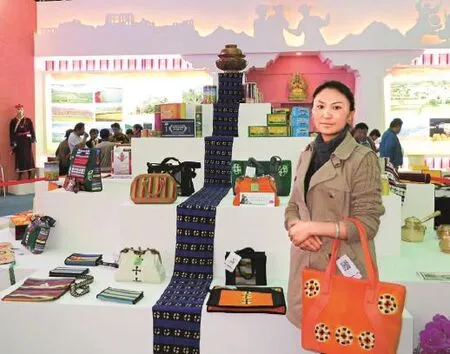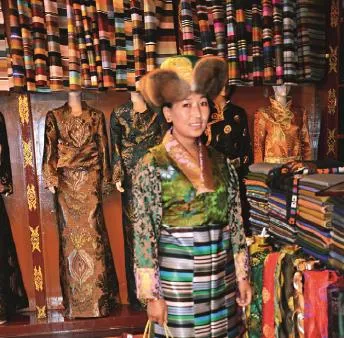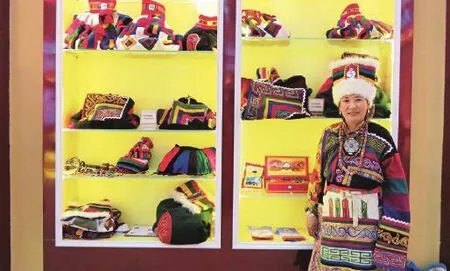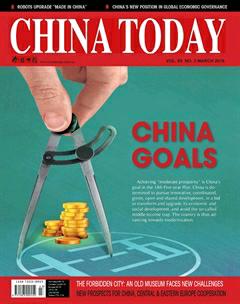Three Tibetan Entrepreneuses Sustain Traditional Craftsmanship
2016-09-14ByMANING
By MA NING
Three Tibetan Entrepreneuses Sustain Traditional Craftsmanship
By MA NING
NURTURED since birth by a strong sense of ethnic culture, some enterprising Tibetan women choose to develop local handicrafts by setting up their own businesses. In creating distinct ethnic brands through hard work and good sense they both inherit and pass on Tibetan craftsmanship and achieve personal fulfillment.

Tsering Drolkar’s products gain public commendation in local areas.
Tsering Drolkar’s Business Empire
Twenty-eight-year-old Tsering Drolkar is the founder of a handicraft cooperative in Lhozhag County, southern Tibet. It specializes in tweed and colorful leather bags. Business is brisk.
Born in 1988, Tsering dropped out of school aged eight. Her parents sent her to her aunt’s family in Tsetang Town, Shannan Prefecture after she turned nine-years-old to look after her newborn cousin. It was there that she gave rein to her instinctive flair for business.
Her aunt’s family owned a vegetable greenhouse. Tsering’s careful management of it produced a yield of cabbages, shallots, and carrots far beyond the household’s daily needs. To earn pocket money she put the surplus vegetables in a bicycle cart and peddled them in the streets – a practice she carried on for the next six years.
In 2002, the 15-year-old’s aunt presented her with RMB 30,000 – the sum of her earnings as child carer and vegetable producer since arriving in Tsetang. Tsering later borrowed RMB 20,000 from other relatives and opened a restaurant, named “Happy Tibetan Food,”that served Tibetan noodles, sweet tea, and curried rice. Her business acumen thus earned Tsering her first pot of gold.
Barely literate, having left school so early, by chatting to customers Tsering gleaned snippets of information on tourism development in Tibet. What she learned prompted her decision to sell her restaurant and explore commercial possibilities. In 2004, she invested RMB 180,000 in a tourist shop trading in Indian and Nepalese commodities. Her business flourished. After July 1, 2006, when the Qinghai-Tibet Railway went into operation, Tibet’s tourism industry blossomed. Following her business instincts, Tsering opened another restaurant and a supermarket specializing in imported food. It earned her an annual net income in excess of RMB 800,000.
Tsering Drolkar has always followed the business philosophy that lifeabounds in opportunities and challenges. After several years of dealing with tourists, she found that holidaymakers were specifically interested in authentic quality ethnic handicrafts, and saw this as a golden opportunity. Tsering transferred the possession of all three of her stores, and in late 2013 invested all her savings – RMB 2.6 million – in establishing the Gabu Ethnic Handicraft Processing Cooperative in Lhozhag County.
Her primary workforce is made up of people from low-income families who have endured hardships and are not afraid of hard work. She initially hired 33 women who had formerly worked as farmers and herders. The chance to improve their living conditions was a strong incentive for them to join the cooperative.
The theory was fine, but the reality tough. At first the cooperative produced more than 40 types of traditional handiworks, including Tibetan wool, bags, hats, garments, and boots. However, the fickle market resulted in the failure of several product lines. The Tibetan wool bags, however, were popular, so Tsering decided to develop a new style. With an investment of several hundred thousand yuan and abundant raw materials, Tsering finally launched her “Lodro” Tibetan bags. They turned out to be a hit product for which she secured independent intellectual property rights.
Successful people understand the value of cooperation. Tsering employs an assistant to help her promote Lodro’s unique features via networking platforms. Her brand is now well-known and she has solved all of its sales teething problems.
The cooperative now has a workforce of 63. Aside from the three men in charge of shipments and transportation, all workers are women aged between 18 and 45. They are kept busy, as the demand of 800 bags a month exceeds the supply. Knowing that quality is the key to sustaining her business, Tsering exercises strict quality control. At the 2015 China Tibet Tourism and Culture Expo (CTTCE) her bags sold out within three days. Tsering is now heading for her next life goal, which is to “enlarge the cooperative’s scale and build a female business empire” for herself and her staff.

The fine workmanship of Butri’s wares attracts a good deal of returned customers.
Butri: Perfect Mix of Old and New
Butri, a 28-year-old Tibetan tweed weaver, runs the Amala Handicraft Development Co., Ltd., which mainly sells Tibetan garments, bags, boots, and scarves.
Butri was gratified after her first participation in the CTTCE at winning the silver award for her products in a contest sponsored by the tourism administration of Xigaze Prefecture. The high sales of her products during the Expo testified to their quality.
Born in Sagya County, Xigaze, Butri is the fourth of nine siblings. At the age of 15, she started to learn Tibetan tweed making techniques from her mother. Under her mother’s meticulous guidance and through her native diligence she mastered the skills within 18 months, and was soon able to make Tibetan tweed independently. When she was 23, Butri married Wangla, who encouraged her to start a business.
In 2010, the couple opened in downtown Xigaze a shop selling traditional Tibetan costumes. The fine workmanship of their wares attracted a good deal of customers, who returned time and again, and the business flourished. In May 2013, Butri set up her own company and hired her female cousin as manager. Aside from one male designer, Ngodrup, her staff comprises female workers aged between 21 and 38. Taking young people as the company’s target group, the firm divides workers’ duties according to the demands of the market. To satisfy the expanding market, four workers specialize in devising bags of unusual design. The remainder manufactures fashionable Tibetan robes.
Having mastered Tibetan tweed craftsmanship, Butri gives full play to her talents by combining Tibetan culture with modern crafts. Among the many unique ethnic handiworks she has created the most successful is a simple scarf with a magic ingredient. Traditional Tibetan wool products are rough and heavy, and so quite at odds with the tastes of modern urban youth. To adapt to their preferences, Butri invested in cashmere from Rutog County, Ngari Prefecture. Together with Ngodrup the designer, she created cashmere scarves featuring distinctive patterns from Tibetan culture. They were a huge success.
During peak tourist season from June to August there is an endless stream of customers for Butri’s products. The company’s annual net income sometimes exceeds RMB 300,000. This year, Butri purchased a three-story building to accommodate her expanding business.

Yutso Droma and a display of her traditional Tibetan apparel.
Yutso Droma: Preserving Traditional Culture
Tibetans in Gertse County of Ngari Prefecture are descended from three tribes – the Senguo, Gaize, and Bangba. Yutso Droma is of the Gaize ethnicity. At age 16, she started learning from her mother the craftsmanship of Gaize clothes and ornaments. Five years later, she was able to make an entire outfit without help. After marrying Lolang of the Senguo tribe she spent six years learning how to make traditional Senguo garments.
Now a 43-year-old mother, Yutso Droma is teaching her second daughter, Sonam Butri, how to make the costumes of her and her husband’s ethnic groups. As part of her apprenticeship, Sonam Butri will undergo two years of needlework, two years of tailoring, one year of material matching, one year learning how to embroider 30 different designs on sheepskin, and a final year learning how to cut a dress according to the wearer’s figure.
Senguo attire features the seven colors of the rainbow, a symbolic gesture celebrating the legend of the cultural icon King Gesar, according to Lolang. It is said that the Senguo tribe is descended from the seven attendants of King Gesar’s wife. Legend has it that when she passed away, a rainbow appeared in the sky, and she ascended to heaven. The Senguo ethnic costumes hence feature the seven colors of the rainbow in memory of the King’s wife.
Improved living standards resulted in a higher demand for quality clothing among residents of Ngari Prefecture. This trend had positive impact on Yutso’s company, as orders came in at a rate far beyond the work capacity of the husband and wife team. In 2009, therefore, they invested RMB 160,000 in setting up a garment company to achieve volume production.
Made from sheepskin, wool, and Tibetan tweed, their striking, superbly made clothes embody the harmonious beauty of humanity and nature. In 2013 these ethnic attires were listed as Tibet’s intangible cultural heritage. Supported by a government fund, the workshop has been expanded and its employees increased from four to 13. The company sold 400 garments in 2014, generating a net income of RMB 140,000. Sales exceeded 900 items in 2015. During the CTTCE, their distinctive clothing drew the attention of several museums.
Attuned to Tibet’s social changes, local female entrepreneurs have established their leading commercial standing through diligence and know-how, so exemplifying the admirable qualities of Tibetan women in this new period.C
MA NING is a professor at Xizang Minzu University.
